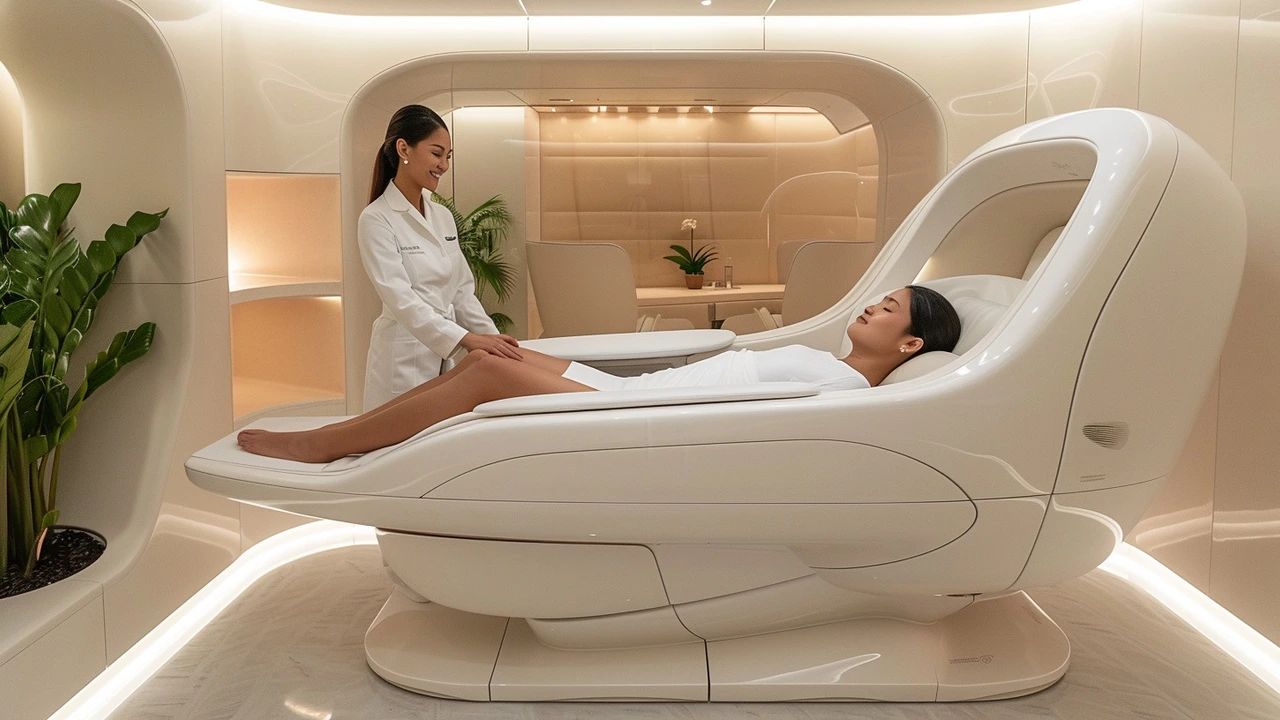Neuromuscular Massage Therapy: Enhancing Muscle Recovery and Pain Relief

Imagine your body as a complex network of muscles and nerves, each prone to the stresses and strains of daily activities. Neuromuscular massage therapy emerges as a beacon of relief not just for the overtly athletic, but for anyone grappling with muscular discomfort and chronic pain. This form of therapy dives deep into the muscle to bring respite and rehabilitation, effectively resetting your body's pain management system.
- What is Neuromuscular Massage?
- Core Benefits
- Techniques Used
- Ideal Candidates
- How to Prepare
- Choosing the Right Therapist
What is Neuromuscular Massage?
Neuromuscular massage therapy, a term that often surfaces in the realms of rehabilitative treatment and personal wellness, is not just a routine massage. It is a thorough engagement with the profound systems of the body that influence muscle pain and dysfunction. Tracing its roots back to the early 20th century, this method was refined through decades of clinical research and practice. Predominantly, it addresses the neuromuscular system—the network of muscles and nerves that execute bodily movements.
The therapy employs techniques that aim to balance the nervous system with the musculoskeletal system. Specialized finger pressure techniques are used to reduce pain, alleviate stress, and encourage the natural healing processes of the body. Each session is tailored to tackle specific pain points and muscular dysfunctions that are unique to each individual. The precision not merely soothes but also enhances overall muscular function and mobility.
Moreover, neuromuscular massage can effectively address multiple causes of bodily pain including postural imbalances, overuse, and injuries accrued through sports or daily activities. By precisely targeting and treating soft tissue abnormalities, therapists assist in restoring homeostasis in the affected areas. Ultimately, this form of therapeutic intervention helps in preempting further muscular damage and reinforcing the body's ability to heal itself.
The effectiveness of neuromuscular massage lies in its rigorous methodology, which significantly contrasts with more conventional forms of massage therapy. Its specificity in targeting only the areas that require attention ensures that it is not just a surface-level solution but a deep-seated remedy for pain and dysfunction.
Core Benefits
The pursuit of robust health and a pain-free life might lead many to the doors of neuromuscular massage therapy. But what makes it significantly beneficial compared to its counterparts? Primarily, it's the ability to target and alleviate sources of pain and discomfort across the body that places neuromuscular therapy in a league of its own. This type of massage is renowned for its effective treatment of chronic pain syndromes, which can originate from various lifestyle or accidental injuries. By focusing on specific neural and muscular junctions, the therapy seeks to restore balance to the body's nervous system, which is crucial for pain management and muscle function.
Another standout benefit is its contribution to improved circulation. Blood flow is vital for healing and repair processes within the body. Neuromuscular massage helps in breaking down adhesions and stimulates blood flow which, in turn, brings more oxygen and nutrients to damaged tissues. This enhanced circulation speeds up recovery times and reduces swelling, marking a significant step towards recovery for athletes or individuals recovering from physical injuries.
The psychological effects of neuromuscular massage should not be underestimated. The relief from pain is often accompanied by a reduction in stress and anxiety levels. Handling pain can exhaust the body's reserves rapidly, leading to feelings of constant fatigue and even depression. Regular sessions of neuromuscular massage have been shown to decrease cortisol levels—the body’s stress hormone—while boosting the production of serotonin and dopamine, neurotransmitters that play a crucial role in our feelings of well-being and happiness.
Improved joint mobility is yet another critical advantage. Over time, with repeated muscle tension and stress, our joints can suffer and become less flexible. Neuromuscular massage works not only on muscles but also on connective tissues, thereby helping to increase range of motion and flexibility. This can be particularly beneficial for people who are aging or those engaged in heavy physical activity that can compact and stiffen the joint areas.
Not just physical therapists but also medical doctors often recommend neuromuscular therapy as an adjunct treatment for various conditions. For instance, patients suffering from conditions such as fibromyalgia, migraine headaches, and even conditions like temporomandibular joint dysfunction (TMJ) have found relief through these specific therapeutic massage techniques.
Techniques Used
In the intricate world of neuromuscular massage, a variety of specific techniques are employed to pinpoint and alleviate deep-seated muscle tension. Fundamental to the practice is the ischemic compression technique, where sustained pressure is carefully applied to trigger points. These are hyperirritable spots found in skeletal muscle that are associated with palpable nodules in taut bands of muscle fibers. The aim here is not merely to induce relaxation but to disrupt the pain pattern, facilitating a decrease in muscle contraction and an increase in blood flow, which promotes healing.
Another critical technique is myofascial release. This involves a gentle, sustained pressure applied to the myofascial connective tissue restrictions. The goal is to eliminate pain and restore motion by relaxing contracted muscles, improving blood and lymphatic circulation, and stimulating the stretch reflex in muscles. Over time, this technique helps in breaking down scar tissue, enhancing movement and flexibility.
The muscle energy technique (MET) is a more interactive method where patients themselves participate actively. Here, patients are guided through specific movements in which they contract their muscles from a precisely controlled position, in a specific direction, and against a therapist-directed force. MET is used to strengthen weak muscles, stretch tight muscles, and improve local circulation, all crucial for injury rehabilitation and pain relief.
On occasion, therapists might integrate elements of movement reeducation which is essential to teach the body healthier patterns of movement. Correcting biomechanical dysfunction can significantly reduce future risk of injury and enhance overall muscle performance.
Ideal Candidates
Neuromuscular massage isn't a cure-all, but it serves as a vital therapeutic option for many. At its core, this therapy is best suited for individuals who face chronic muscular pain, those recovering from certain types of injuries, or anyone experiencing tension and discomfort that hinders their daily functioning. Whether it's a desk job leading to back and neck pain, or a sports-related strain that refuses to fade away, neuromuscular massage provides targeted relief that can markedly improve one's quality of life. This therapy is particularly beneficial for those who haven't found relief through more conventional methods and are looking for a deeply restorative experience.
Such individuals often include office workers, athletes, manual laborers, and the elderly, but the range does not end there. People who experience frequent headaches, those with postural issues, or patients recovering from surgeries can also find significant benefits from neuromuscular therapy. It is not about being in a specific demographic but more about the specific muscular and neuromuscular needs that an individual might have. Striking the right balance between muscle relaxation and therapeutic pain can dramatically alter recovery trajectories and daily comfort levels.
How to Prepare
Embarking on a journey with neuromuscular massage therapy requires a bit more than just showing up at the therapist’s office. Preparation can significantly enhance the effectiveness of your session and improve the therapeutic experience. Firstly, it’s crucial to ensure that your body is adequately hydrated. Drinking plenty of water before a session helps in loosening the tissues and facilitates easier manipulation for the therapist. Hydration isn't merely a suggestion; it's an essential step toward ensuring your muscles are pliable and responsive to the treatment.
Next, wearing comfortable clothing is key. You might be asked to perform certain stretches or movements, and restrictive attire can hinder this process. Opt for loose, breathable fabrics that allow for flexibility and ease of movement. Additionally, consider avoiding heavy meals right before your session. A light meal a few hours beforehand ensures that your body isn’t diverting its energy towards digestion during your massage. This allows you to relax more deeply and respond better to the therapy.
It’s also helpful to have a clear communication with your therapist about your pain thresholds and any specific areas of discomfort. Before starting the session, discuss your pain points and any relevant medical history. This dialogue is critical as it guides the therapist in customizing the session to your unique needs, ensuring safety and maximizing therapeutic outcomes. Keeping an open line of communication fosters a trustful and receptive environment, which can make all the difference in your treatment’s success.
To further ensure a fruitful session, engage in a mild warm-up if possible. Simple stretches or a brief walk can increase blood flow and loosen up the muscles. This preparatory activity signals your body to 'wake up' and ready itself for the deeper work that neuromuscular massage entails. Remember, the goal is not just symptom relief but also holistic relaxation and rejuvenation of the muscle groups being targeted. Your preparation enhances not only the immediate effects of the massage but also its lingering benefits.
Lastly, consider scheduling your session at a time when you can relax afterward. Avoid planning strenuous activities post-massage as it can diminish the effects of the therapy. Instead, allow your body time to incorporate and enhance the therapy’s benefits. A gentle, unwinding period post-massage can help in prolonging muscle relaxation and aiding in overall recovery. In summary, thoughtful preparation going into your neuromuscular massage can greatly amplify the positive outcomes, aligning directly with your health and wellness goals.
Choosing the Right Therapist
Finding an adept neuromuscular massage therapist is akin to discovering a skilled craftsman who understands the intricate weave of your body's musculature. The choice of therapist is crucial, not only because effective treatment hinges on their expertise, but also because the therapeutic relationship is built on trust and understanding. When seeking out a therapist, consider their certification and educational background. A practitioner well-versed in neuromuscular therapy typically holds certifications that are specific to this type of treatment, ensuring they have a deep understanding of the complex interplay between nerves and muscle groups.
Beyond the technical skills, the right therapist should exhibit a deep empathetic connection to their patient's condition. They should offer a listening ear and adapt their techniques to align with individual pain thresholds and concerns. This bespoke approach is significant because each person's body reacts differently to massage, and tailoring the experience is key to achieving the best outcomes. Discussing your specific pain points and previous injuries with a potential therapist will help them prepare a personalized plan that addresses your unique needs. This dialogue is essential for setting the expectations and goals for your treatment.
Lastly, don't forget to consider the logistics. Is the therapist's office located in a place accessible to you? Are their operating hours compatible with your schedule? Ease of access and convenience can play a significant role in your therapy journey, affecting how consistently you can attend sessions, which is pivotal for longer-term treatment success. Assessing these practical aspects ensures that your path to recovery is as smooth as possible.





